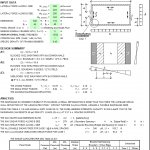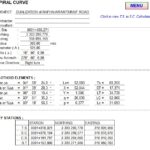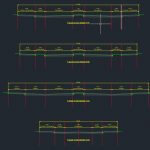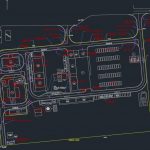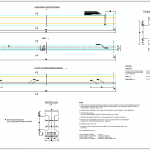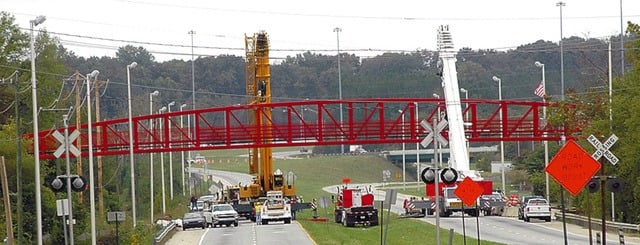
BRIDGE REHABILITATION TECHNIQUES
17 February 2019Table of Contents
1. Introduction
Modern bridge infrastructure comprises of primarily concrete (reinforced or pre-stressed) and steel structures. Over the service life of a bridge, its constituent materials are continually subjected to fatigue and wear-tear due to dynamic vehicular loads. Overloading due to increase in wheel loads and regular exposure to aggressive external environment may aggravate the situation further.
Post-tensioned concrete bridges may also exhibit loss in pre-stress overtime, resulting in drop in load carrying capacities of the affected members. Poor quality of construction and lack of regular maintenance could potentially lead to major retrofit in a bridge structure. Furthermore, components facilitating expansion/ contraction of bridge and load transfer to the sub-structure, such as expansion joints & bearings, may also require rehabilitation or replacement over time.
Defects in the constituent materials may be manifested in the form of cracking – spalling of concrete, excessive deflection of structure, corrosion of steel components/ reinforcement etc. It is evident that rehabilitation of bridges involves addressing a myriad of problems and no single technique or retrofit method could offer a complete solution. Therefore, answer lies in being able to address each individual problem with an appropriate technique to result in a durable retrofit. This article aims at providing an overview of a variety of structural retrofit techniques available to rehabilitate bridges.
2. Reinforced / Pre-stressed Concrete Bridges
Most of the structural repair and retrofitting techniques used for ordinary reinforced concrete are applicable to reinforced concrete bridges as well. Structural repair techniques include crack injection with low viscosity epoxy and patch repair using an approved material such as polymer modified mortar or non-shrink grout. Strengthening techniques include concrete jacketing, steel plate or FRP (fibre reinforced polymer) bonding on the external surface of the member to be retrofitted.
For strengthening of pre-stressed concrete structures, external post-tensioning or FRP retrofit may be appropriate.
Concrete jacketing
Involves increasing size of the existing reinforced concrete section by adding more reinforcement and concrete. It could be accomplished by either of the following methods:
1. Conventional Concrete – Pouring concrete around the member to be strengthened with additional steel reinforcement properly anchored to the existing section. Ordinary concrete jacketing requires formwork and is time consuming due to long curing time. Furthermore, it is difficult to achieve a dense mix in constrained conditions. Adhesion is also an issue, especially for overhead applications.
2. Sprayed Concrete (Shotcrete) – Pneumatically projecting concrete on to the reinforced (usually with wire mesh) and prepared surface of the member being strengthened with a spray gun. A variety of additives and admixtures are also introduced to expedite strength gain, reduce rebound, reduce water requirement, curb shrinkage and improve adhesion.
The grading of aggregates is critical in sprayed concrete due to the absence of external vibration and the reduction in the quantity of coarse aggregates as a result of rebound. Shotcrete does not require formwork and is useful to retrofit large areas in a relatively short period of time. But, the operation is very messy with enormous loss of sprayed materials, resulting not only wastage of materials but an unsightly-rough surface finish too. It is not economical for small areas of retrofit due to high setup and machinery costs.
3. Pre-Packed Aggregate Grouting – Pumping of cementitious grout into washed/ graded coarse aggregates placed with properly anchored reinforcement around the member to be strengthened in a tightly sealed formwork. It is one of the better ways of jacketing a concrete member as it results in a dense mix with good surface finish.
Regardless of the method deployed, jacketing results in increase in dimensions as well as dead weight of the retrofitted member.
Steel Plate Bonding
This technique involves enhancing strength (shear, flexure, compression) or improving stiffness of deficient reinforced concrete members by bonding steel plates of calculated thickness with adhesives and anchors to the existing sections.
Steel plate not only acts as externally bonded reinforcement to the concrete section but it also improves the moment of inertia (stiffness) of the composite (concrete-steel) section. This technique is useful for the flexural and shear strengthening of bending elements such as beams and slabs and for compression capacity enhancement of columns.
Steel plate bonding is a cumbersome process requiring extensive hacking & drilling in the existing section. Steel plates are hard to lift and need to be tailor made to suit to the as-built dimensions of the members. Resulting surface finish is unsightly and steel plate retrofit is prone to corrosion over time.
FRP Strengthening
A Fibre Reinforced Polymer (FRP) typically consists of high tensile continuous fibres oriented in a desired direction in a speciality resin matrix. These continuous fibres are bonded to the external surface of the member to be strengthened in the direction of tensile force or as confining reinforcement normal to its axis. FRP can enhance shear, flexural, compression capacity and ductility of the deficient member.
Aramid, carbon, and glass fibres are the most common types of fibres used in the majority of commercially available FRPs. FRP systems, commonly used for structural applications, come in many forms including wet lay-up (fibre sheets or fabrics saturated at site), pre-preg (pre-impregnated fibre sheets of fabrics off site) and pre-cured (composite sheets and shapes manufactured off-site).
The properties of an FRP system shall be characterized as a composite, recognizing not just the material properties of the individual fibres, but also the efficiency of the fibre-resin system and fabric architecture.
FRP strengthening is a quick, neat, effective, and aesthetically pleasing technique to rehabilitate reinforced and pre-stressed concrete structures. Unlike steel plates, FRP systems possess high strength to self-weight ratio and do not corrode. But, it is imperative to be aware of the performance characteristics of various FRP systems under different circumstances to select a durable and suitable system for a particular application.
It should be ensured that the FRP system selected for structural strengthening has undergone durability testing consistent with the application environment and structural testing in accordance with the anticipated service conditions. Suitably designed protective coatings may also be applied on an FRP system to protect it from exposure to adverse environmental conditions (acids, saltwater, UV exposure, impact, temperature, fire etc.).
External Post-Tensioning
Over the service life of a pre-stressed concrete member, loss in pres-stress may occur due to a variety of reasons. Post-tensioned bridges can be effectively rehabilitated by external post-tensioning technique to compensate for loss in pre-stress or increase in wheel loads.
In this technique, pre-stressing tendons or bars are located according to pre-determined profile on the external surface of the member to be strengthened according to design. Anchor heads are positioned at the ends of these tendons/ bars to post-tension the member using hydraulic jacks.
Although, this method is quite effective but it requires sufficient strength in the existing concrete to transfer the stress and exposed tendons & anchorages need to be protected against corrosion and vandalism.
3. Steel/ Composite Bridges
Components of a steel bridge need to be continually protected against environmental corrosion. Proper care needs to be exercised to maintain critical elements such as piles, piers, decks, suspension cables etc.
Piles and piers may be rehabilitated using bonded steel plates or FRP strengthening/ protection. Steel bridges are generally covered with a concrete decking, which gets worn off over time due to cyclic dynamic loads. It is a time consuming and cumbersome process to retrofit reinforced concrete decks with conventional methods. The following techniques are useful to rehabilitate a steel bridge deck:
Bridge Deck Replacement
Exodermic™Bridge Deck (www.dsbrown.com) is a modular deck replacement system consisting of a reinforced concrete slab composite with an unfilled steel grid. This arrangement maximizes the use of the compressive strength of concrete and the tensile strength of steel. Top portions of the main bars of the steel grid are specially designed with perforations that get embedded into the concrete to effectively transfer horizontal shear. The concrete component can be precast before the panels are installed on the bridge, or cast-in-place.
Overall thickness of the system ranges between 150mm and 250mm. The system is designed to speed up the construction process while reducing the dead load. A typical application weighs 35 to 50 percent less than a reinforced concrete deck that would be specified for the same span. It not only helps reduce dead load on the sub-structure but also enables bridge structure to sustain higher live loads.
The panelized nature of the Exodermic™ design is well suited for rapid, even overnight, redecking projects.
Bridge Cable Protection
Cableguard™ Elastomeric Wrap system (www.dsbrown.com) is a corrosion protection system exclusively developed to protect bridge cables, applicable during construction or rehabilitation of cable-stayed and suspension bridges.
The patented wrap material is based on cross-linking a chlorosulfonated polyethylene polymer that is manufactured into a three ply (polymer-fabric reinforcement-polymer) laminated construction. It comes in a wide variety of colours and hence, does not require painting.
Cableguard™ Elastomeric wrap is applied directly over existing cable coating using a Skewmaster™ automatic wrapping device to encapsulate the entire cable. Wrap is heated to fuse its overlapped portion and shrink it snuggly to the cable surface to result in an impermeable barrier against intrusion of moisture into the cable.
Although, the Cableguard™ wrap shrinks securely on the cable, it does not fuse or bond to the cable. Therefore, partial removal for inspection of the internal strands is not impaired. Application does not require sandblasting, high-pressure washing or any type of solvent cleaning, eliminating need for containment and disposal of hazardous materials.
Cableguard™ Elastomeric Wrap system presents a watertight sealing mechanism to protect bridge cables from corrosion and premature failure.
4. Rehabilitation of Expansion Joints and Bearings
Expansion Joints
Bridge expansion joints allow movement (expansion and contraction) resulting from temperature changes, shrinkage and creep etc. in the bridge structure, while maintaining its watertight integrity. Like bridge deck, they are continually subjected to dynamic vehicular wheel loads, wear & tear, and fatigue during their service lives.
Depending upon their movement capacities and make, expansion joints may fall into the categories of bituminous, rubberized or mechanical joints. They may also be categorized as bolted-down or positively anchored on the basis of their mode of anchorage with the bridge deck.
Generally, rubberized and finger bolt-down joints tend to loosen over time with the application of wheel loads. Upon loosening, dynamic forces are accentuated further that hamper proper functioning of the system as well as riding quality.
Sealing elements may also get damaged overtime due to wear and tear. Large movement joints such as modular expansion joint assemblies may also require replacement of their elastomeric components during their service lives.
Rehabilitation of bridge expansion joints poses the challenge of replacing the components or complete joint without disrupting traffic flow.
Generally, replacement is carried out lane by lane during off-peak hours to allow the traffic flow while work is underway. To accomplish, replacement of expansion joint with in a short period of time, it is important that the system proposed meets the following criteria:
1. Joint can be installed in a shallow box-out to limit cutting & hacking
2. Joint can be installed lane by lane
3. Nosing material is elastic and bonds well with the deck concrete and expansion joint mechanical elements
4. Nosing material sets quickly (less than an hour or so) without special curing requirements
5. System provides a water-tight integrity Delcrete™ Strip Seal Expansion joint systems (www.dsbrowm.com) meet all above-mentioned criteria and present an ideal solution to rehabilitate bridge expansion joints. Delcrete™ is a pour- in-place, free flowing, two-part polyurethane-based elastomeric concrete.
It has been compounded to bond to a variety of surfaces including steel and concrete. It is non-brittle over extreme temperature ranges, resistant to nearly all chemicals and has one-hour cure time.
Bridge Bearings
Bridge bearings primarily carry out the following functions:
1. Create a desired support system for the bridge superstructure
2. Transfer loads from the super-structure to the sub-structure
3. Allow movement and rotation of the superstructure Like expansion joints, bridge bearings also come in various types, makes and materials.
They fall into two broad categories of elastomeric and mechanical bearings. Elastomeric bearings are generally composed of neoprene or natural rubber, with or without steel plate reinforcement.
Mechanical bearings may be categorized into mechanical pot, roller, rocker, knuckle, or disc bearings. Defects in elastomeric bearings may be manifested in the form of cracking or tearing of elastomeric material, slip of steel reinforcing layer or the bearing itself, excessive shear movement in the bearing etc.
Mechanical bearings may also exhibit signs of distress during their service lives in the form of excessive movement/ rotation, bearing failure at sub-structure or super-structure, dislodging of components such as sliding surfaces/ materials, failure of anchorage systems etc. In most of these situations, it is advisable to replace the complete bearing assembly with a new one.
Therefore, provisions must be made at the design stage itself to ensure easy replaceability of structural bearings at a future date. To replace existing bridge bearing, it is necessary to make alternative arrangements for load transfer from the superstructure to the sub-structure during the duration of replacement.
Normally, hydraulic jacks are used to lift the bridge superstructure for replacement of the affected bearing. If the bridge sub-structure has sufficient space in the vicinity of the bearing to be replaced, then the hydraulic jacks can be placed on the substructure itself, otherwise supporting frame is erected from ground or friction gripped to the bridge pier to support the jacking arrangement. Bearing replacement exercise involves careful consideration of bearing pressures, effective load transfer mechanisms, ensuring balanced-gradual lifting and stability of superstructure, and speed of replacement.

